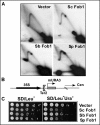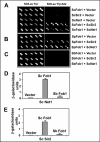Replication fork arrest and rDNA silencing are two independent and separable functions of the replication terminator protein Fob1 of Saccharomyces cerevisiae
- PMID: 20179323
- PMCID: PMC2857089
- DOI: 10.1074/jbc.M109.082388
Replication fork arrest and rDNA silencing are two independent and separable functions of the replication terminator protein Fob1 of Saccharomyces cerevisiae
Abstract
The replication terminator protein Fob1 of Saccharomyces cerevisiae is multifunctional, and it not only promotes polar replication fork arrest at the tandem Ter sites located in the intergenic spacer region of rDNA but also loads the NAD-dependent histone deacetylase Sir2 at Ter sites via a protein complex called RENT (regulator of nucleolar silencing and telophase exit). Sir2 is a component of the RENT complex, and its loading not only silences intrachromatid recombination in rDNA but also RNA polymerase II-catalyzed transcription. Here, we present three lines of evidence showing that the two aforementioned activities of Fob1 are independent of each other as well as functionally separable. First, a Fob1 ortholog of Saccharomyces bayanus expressed in a fob1Delta strain of S. cerevisiae restored polar fork arrest at Ter but not rDNA silencing. Second, a mutant form (I407T) of S. cerevisiae Fob1 retained normal fork arresting activity but was partially defective in rDNA silencing. We further show that the silencing defect of S. bayanus Fob1 and the Iota407Tau mutant of S. cerevisiae Fob1 were caused by the failure of the proteins to interact with two members of the S. cerevisiae RENT complex, namely S. cerevisiae Sir2 and S. cerevisiae Net1. Third, deletions of the intra-S phase checkpoint proteins Tof1 and Csm3 abolished fork arrest by Fob1 at Ter without causing loss of silencing. Taken together, the data support the conclusion that unlike some other functions of Fob1, rDNA silencing at Ter is independent of fork arrest.
Figures






Similar articles
-
Association of the RENT complex with nontranscribed and coding regions of rDNA and a regional requirement for the replication fork block protein Fob1 in rDNA silencing.Genes Dev. 2003 Sep 1;17(17):2162-76. doi: 10.1101/gad.1108403. Epub 2003 Aug 15. Genes Dev. 2003. PMID: 12923057 Free PMC article.
-
Mechanism of Regulation of Intrachromatid Recombination and Long-Range Chromosome Interactions in Saccharomyces cerevisiae.Mol Cell Biol. 2016 May 2;36(10):1451-63. doi: 10.1128/MCB.01100-15. Print 2016 May 15. Mol Cell Biol. 2016. PMID: 26951198 Free PMC article.
-
Contrasting roles of checkpoint proteins as recombination modulators at Fob1-Ter complexes with or without fork arrest.Eukaryot Cell. 2009 Apr;8(4):487-95. doi: 10.1128/EC.00382-08. Epub 2009 Feb 20. Eukaryot Cell. 2009. PMID: 19234097 Free PMC article.
-
The implication of Sir2 in replicative aging and senescence in Saccharomyces cerevisiae.Aging (Albany NY). 2011 Mar;3(3):319-24. doi: 10.18632/aging.100299. Aging (Albany NY). 2011. PMID: 21415463 Free PMC article. Review.
-
DNA protein interactions at the rRNA of Saccharomyces cerevisiae.Ital J Biochem. 2007 Jun;56(2):81-90. Ital J Biochem. 2007. PMID: 17722648 Review.
Cited by
-
Budding Yeast Rif1 Controls Genome Integrity by Inhibiting rDNA Replication.PLoS Genet. 2016 Nov 7;12(11):e1006414. doi: 10.1371/journal.pgen.1006414. eCollection 2016 Nov. PLoS Genet. 2016. PMID: 27820830 Free PMC article.
-
Smc5/6 in the rDNA modulates lifespan independently of Fob1.Aging Cell. 2021 Jun;20(6):e13373. doi: 10.1111/acel.13373. Epub 2021 May 12. Aging Cell. 2021. PMID: 33979898 Free PMC article.
-
The Nuts and Bolts of Transcriptionally Silent Chromatin in Saccharomyces cerevisiae.Genetics. 2016 Aug;203(4):1563-99. doi: 10.1534/genetics.112.145243. Genetics. 2016. PMID: 27516616 Free PMC article. Review.
-
RNA Polymerase I and Fob1 contributions to transcriptional silencing at the yeast rDNA locus.Nucleic Acids Res. 2016 Jul 27;44(13):6173-84. doi: 10.1093/nar/gkw212. Epub 2016 Apr 8. Nucleic Acids Res. 2016. PMID: 27060141 Free PMC article.
-
Mitotic exit and separation of mother and daughter cells.Genetics. 2012 Dec;192(4):1165-202. doi: 10.1534/genetics.112.145516. Genetics. 2012. PMID: 23212898 Free PMC article. Review.
References
-
- Mohanty B. K., Bastia D. (2004) J. Biol. Chem. 279, 1932–1941 - PubMed
Publication types
MeSH terms
Substances
Grants and funding
LinkOut - more resources
Full Text Sources
Molecular Biology Databases

